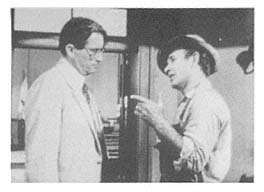The Bad Father
Although the trial might introduce ambivalence to Scout's idealization of her father, true antipathy is precluded with Bob Ewell around. The polar opposite of Atticus throughout the film, Ewell is the dark side of paternal authority that Atticus's liberal, maternal goodness conceals. The Methodist teetotaler confronts the alcoholic when Ewell staggers up to the car to glare menacingly at Jem as Jem waits outside the Robinson house for his father.

Atticus always wears a suit and a tie (at home a sweater and a tie), while Ewell throws a jacket over his overalls and scrunches a hat on his head as he sways in the street yelling "nigger-lover" after the Finch's departing car. In place of Atticus's measured, thoughtful reasoning, Ewell asserts the "time-honored" wisdom of racist slurs. More important, where Atticus uses stern disapproval to browbeat Mayella, the testimony at the trial draws a vivid picture of Ewell's style of fatherhood—physically beating his daughter to repress her sexuality. Both fathers are repressive; it comes down to a matter of degree. Ewell and Atticus's deeper relationship as the dual sides of the role of the father is revealed in their complementary actions. Ewell's abuse of the law prompts Atticus's exposure of Ewell's daughter, Mayella. Atticus's actions as the enforcer of the law looses Ewell on Atticus's children.
Some time after the trial, when Jem and Scout are returning from an agricultural pageant, Scout finds out what it can mean to be a woman. She has been transformed by costume into a representative of one of the state's prime agricultural products, a ham. In the dark, threatening woods between school and home, the instinctual violence her father's law means to control is unleashed. The good father, whose actions have provoked the attack, is nowhere to be found.
The scene is presented through the severely restricted vision of Scout. A man grabs Jem and breaks his arm, but before he can hurt Scout, immobilized by her costume, another figure appears. As a close-up of Scout's eyes shows her desperately trying to see what is happening, we hear the heavy breathing of a struggle. Scout, choosing between the confinement of respectability and near-nakedness, wriggles out of her costume and runs home. In the distance, she sees a man carrying Jem up the front steps. Atticus runs out of the house and Scout jumps into his arms. As the police chief and Atticus grill Scout to find out who was fighting with Ewell, Scout points to a shadowy figure behind the bedroom door. "Why, there he is. He can tell you his name. Hey, Boo!" And Boo Radley, never before seen, emerges from the shadows.
Although they had never seen him, Boo has played a major role in the fantasy lives of Scout and Jem. The children dare each other to go near his house. He leaves them trinkets in the hollow of a tree, which they save and keep secret from Atticus. Boo lives in the kind of old dark house Annette Kuhn calls "the classic 'other scene,' the site precisely of enigma and mystery."[24] The "Radley place," like the house Kuhn describes from The Big Sleep, is the object of the children's "obsessive return," and the subject of major set pieces in the film's first half (Scout's precarious inner-tube ride that crashes her into the front porch, Jem's brave venturing to touch the front door, the nighttime raid, etc.). The children's secret project of "making Boo come out," of making the house divulge its mysterious tenant, is interrupted by the trial and its consequences. But the house returns in the film's penultimate scenes, with Boo himself as the answer to the final enigma.
Boo stands as the test case that proves the superiority of literature over the law. When it becomes apparent that Boo stabbed Bob Ewell in order to save the children, Atticus tells the sheriff there will have to be a trial. Although he owes his children's lives to Boo, Atticus cannot break free of the law's "guilty or not guilty." Boo, however, confounds and subdues the logic of the law. The sheriff urges the interests of a "higher" law—compassion. Scout concurs. As she did at the jailhouse, Scout gently indicates the limits of her father's law. By translating Atticus's literal prohibition against killing mockingbirds into a more powerful metaphorical one, she explains that Boo is like the mockingbird, only seeking to please, and it would be a sin to cause him harm. Together with the sheriff, Scout in effect makes Atticus party to a cover-up.
Boo not only exceeds the law's restrictive binarism, he is explicitly inarticulate. His story must be told by someone else. It is Scout who argues his case, takes him by the hand and walks him home. As she stands alone on the Radley porch. The victorious discoverer and interpreter of the "other scene," the narrator returns on the sound track in a wash of lush Southernisms set against Elmer Bernstein's delicate, emotion-laden score.
The summer that had begun so long ago had ended and another summer had taken its place . . . and a fall . . . and Boo Radley had come out. I was to think of these days many times, of Jem and Dill and Boo Radley and Tom Robinson. And Atticus.
He would be in Jem's room all night. And he would be there . . . when Jem waked up in the mornin'.
Back home, Scout crawls into her father's lap. The father can now be restored because the law has been subtly but firmly displaced.